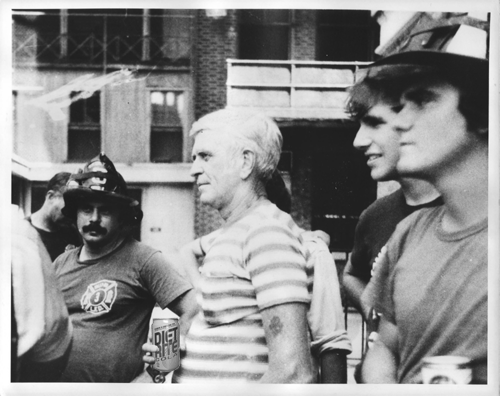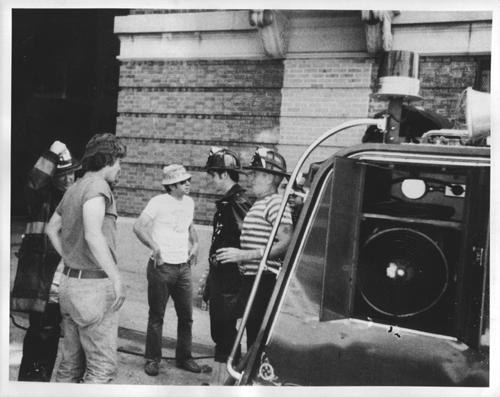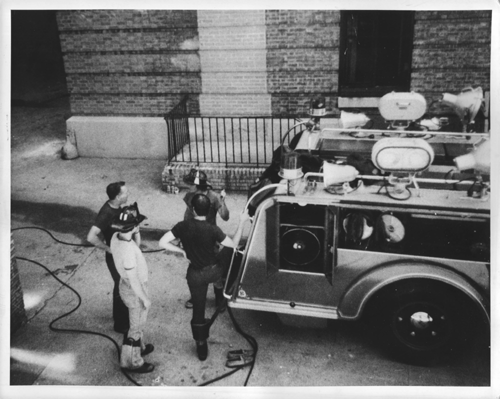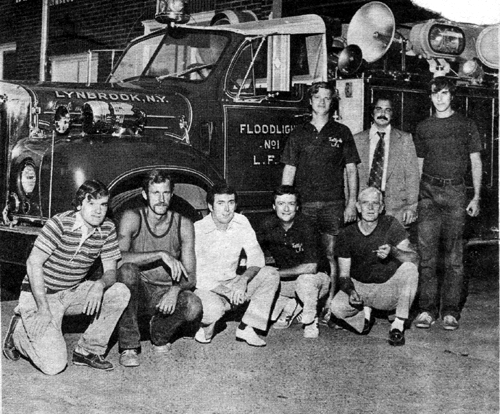Floodlight
History
The Floodlight Unit of the Lynbrook Fire Department
was formed in 1938. This unit is made up of
firefighters who also belong to the five fire
companies and the Medical Company. Most
residents have seen the unit at one time or another
at a fire scene or numerous official village
functions. Floodlight (426) is the truck
with the lights and floodlight towers. At fire
scenes, besides providing the needed lights inside
the fire scene as well as the use of the towers to
light up the whole area, the unit is also the fire
department’s Command Post. The Command Post
handles all radio and phone communications at major
fire scenes. The officers working inside the
Floodlight truck relay all communications from the
fire chiefs to other companies as well as to Nassau
County’s Fire Communications, better known as
FIRECOM, and the neighboring communities who may
also respond when help is needed. They also
keep a log of all the communications that take place
and other functions and activities during a major
fire. The Floodlight truck has a
self-contained generator that powers the many lights
that are carried on the truck. In 1977 the
Floodlight generator was used to save the lives of
countless newborns when it was used to power a
hospital nursery during the New York City blackout
of July 14, 1977.

On December 9, 2007, the
Floodlight Unit of the Lynbrook Fire Department
celebrated an important day when their new
Floodlight Command vehicle, built by Marion Motor
Works, and seen on the opening page of the
Floodlight Unit, was christened with the traditional
wet-down ceremonies. This is the unit’s fourth
vehicle. But nothing in the 70 year history of the
unit was as important as the day in 1977 when the
unit responded on a rare request to New York City.
Their mutual aid response to the Blackout of 1977
saved the lives of 41 babies in the pediatric ward
of a Brooklyn Hospital. Here is that
story of 30 years ago.
Shortly after 3:00 AM on the
morning of the Big Apple blackout, July 14, 1977,
the Lynbrook volunteers of the Floodlight Unit were
awakened for their unit to respond to Bellevue
Hospital in Manhattan which was in desperate need of
a generator to light up portions of that darkened
hospital. The Floodlight truck, back then,
contained a 15 KW generator, along with a portable 5
KW generator unit. The Floodlight members who
responded were Bill Dauscher, Bill Hahl, Bob
Shephard, Captain Gordon MacLeman, Lieutenant Jerry
McLaughlin, Fred Pearsall, Peter Skeris, Michael
Misterly, Artie DeCelle, and Robert Meier. All
of them were also members of Lynbrook’s Tally-Ho
Engine Company 3, where the Floodlight Unit was then
housed. The Floodlight responded to the
city that morning led by Third Deputy Chief William
Quinn, a member of Engine Company 1. Chief
Quinn, in his chief’s car, led the Floodlight truck
along the darkened highways to the Queens Midtown
tunnel where one lane was opened just for them to
get into Manhattan. The only lights were the
headlights and the revolving red lights on both fire
vehicles.

When the firefighters reached
Bellevue they learned that another generator had
been found but that one was desperately needed at
Brooklyn Jewish Hospital in the Bedford-Stuyvesant
section of Brooklyn. They were told that
newborn and premature babies were dying because of
the lack of electricity to keep them warm.
They were also told that babies were being wrapped
in aluminum foil to help maintain their body
temperature. Somehow the Brooklyn Jewish
Hospital’s back up generator had failed. Lt.
McLaughlin would later tell New York Newsday in a
story that, “We had calls coming over the air that
babies were dying in the hospital.”
The volunteers raced from
Manhattan to Brooklyn to help. Immediately
upon their arrival at Brooklyn Jewish Hospital, just
after 4 AM, Bob Shephard, a Long Island Lighting
Company employee, and Fred Pearsall, a New York
Telephone employee, ran a power line through a
window of the hospital and hooked up the truck’s
generator to the hospital’s electrical system.
The first to receive electricity from the fire truck
was the incubators in the neo-natal nursery where 41
babies were near death from the lack of heat.
With the power back on, all the babies would
survive. One doctor would say in a Newsday
article that because babies have no fat they lose
heat fast which could result in cardiac arrest or
serious breathing problems.

The volunteers also ran
additional power lines from the truck and using
portable lights were able to light up five floors of
the hospital. One firefighter even crawled
through a window with a portable light so that a
pharmacist could get the prescribed medication he
desperately needed from the darkened pharmacy.
They were also able to power the hospital’s paging
system so that doctors could be called.
The volunteer firefighters
would later say that while they were working to get
electricity into the building that emergency room
doctors were outside in the parking lot operating on
people under the lights of a small portable
generator provided by FDNY. One firefighter
said that rioting was going on in the surrounding
neighborhood of the hospital and that gun shots
could be heard in the distant darkness. Lt.
McLaughlin would also later tell Newsday that about
60 people had surgery in the hospital parking lot
and that 36 of them had been hurt in the rioting.
Lynbrook’s Floodlight
volunteers stayed at Brooklyn Jewish Hospital
maintaining the power into the hospital from their
fire truck for over 15 hours until they were
relieved by the National Guard who brought in a
generator and took over. The president
of Brooklyn Jewish Hospital, then officially called,
The Jewish Hospital and Medical Center of Brooklyn,
would later send a letter thanking the Lynbrook
Floodlight volunteers for their help and say,
“Because of your help 41 premature and extremely
sick newborn infants are alive today. On
behalf of the families of these infants and our
hospital, we wish to thank you.”

It is hard to believe that
thirty years have passed. All of those babies
in the neo-natal nursery that day lived and now
would be grown ups themselves because of the efforts
of those Lynbrook volunteers. Of the original
group of firefighters that responded that day only
Bill Dauscher and Bill Hahl, are still members of
the Floodlight Unit and Tally-Ho Engine 3. The
other members have moved away, and Chief Quinn has
passed away.